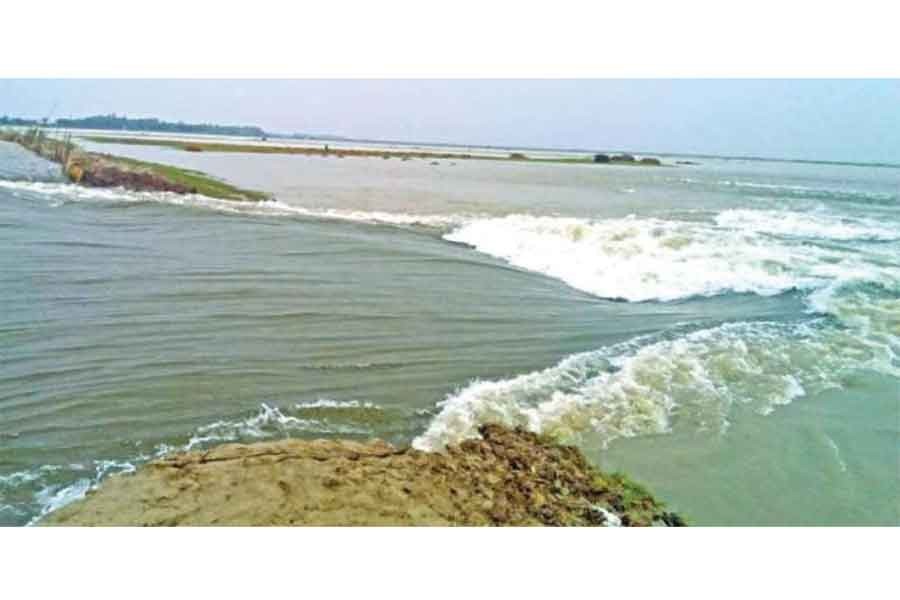The country's haor areas may suffer huge crop-loss in next boro season if the repair work of embankments for protecting crops can not be started in time. The Project Implementation Committees (PICs) for conducting the repair work are yet to be formed.
Flash floods caused huge damage in haor areas this year due to early rains, flash floods and corruption in implementing embankment-repair and construction projects. The agricultural and health-related loss, resulting from the early flash floods in the six haor districts, was estimated at TK 29.42 billion.
Haor areas have a large contribution to the total production of Boro, the main crop in the largely mono-crop agricultural system there. But early flash floods often wash away standing crops causing loss of harvest.
In early 20th century, landlords used to build low, earthen embankments to protect their boro harvest. These embankments were built along periphery of the wetlands and there were structures at the intersection of the embankments and canals to drain out water to protect boro crops. However, these embankments were inundated and remained under water during monsoon period.
Construction of earthen embankments has, therefore, developed as a conventional practice for protecting people's lives and homes, agriculture and infrastructures.
During the last few decades, nearly 13000 km of embankments have been repaired in the country.
There is nearly 4500 km of low-lying embankments along the small rivers, haors and canals in the country. But, earthen embankments get damaged due to erosion and breaching every year.
Embankments can obstruct the flash flood water for several days, providing people the time for harvesting before the land is completely inundated.
Bangladesh Water Development Board (BWDB) is the main government agency which is responsible for implementing flood protection projects.
Considering the vulnerabilities of the haor areas, the concerned department and authorities may consider following suggestions:
- Immediate actions are needed to complete repair work of earthen embankments and dykes in the vulnerable spots of haor region in collaboration with local community in time
- Appropriate allocation, timely release of fund and effective monitoring and supervision of these kinds of emergency work should be ensured by authorities responsible at different levels.
- Role of local governments and communities at the different stages of the works needs to be emphasised by the authorities.
- Constructing submergible embankments is a smart and economically viable way of interventions to help the people of the haor.
- But, proper completion of physical works may sometimes become difficult. There should be sufficient involvement of local people for timely interventions during an emergency.
- Impact-minimising strategies, such as the use of cropping patterns, which minimise exposure to loss, and the setting up of non-agricultural income-generating activities need to be promoted.
- Crop type and pattern should be selected according to the nature of flood. Supply of flood-resistant quality seed, fertiliser and other facilities should be ensured through a coordinated and people-friendly manner.
- Any livelihood initiative in the haor areas has to take flood aspects into consideration so that the initiative does not become futile, rather yield some amount of benefit to the target people.
- Involvement of the community and incorporating their inputs in programme-design, will make the intervention process easier and impact-bearing.
- Mainstreaming Disaster Risk Reduction and Climate Change Adaptation in existing development works and future initiatives of different government departments and NGOs, working in the area, are imperative.
- Concerned authorities should develop disaster data-base which is very important to carry out detailed study and planning.
- Government and NGOs need to redesign their development programmes with the active participation of the vulnerable communities to ensure that these designs maximise flood mitigation potential and incorporate traditional community coping practices which are fit technically, environmentally and economically.
- The respective authorities at different levels should strengthen capacity-building initiatives of local government and villagers. A well organised and coordinated effort is needed to further strengthen local-level planning, decision-making process and to ensure proper allocation of resources to local government for flash flood-proof programme in the vulnerable location.
- Proper resources from central government and others should be ensured by authorities and policy makers in time while introducing a people-centric, and transparent monitoring system.
- Lists of contractors and PIC members along with their names, cell numbers, roles and responsibilities should be made publicly available.
- A complaint box can be set up in every scheme-site to have the feed-back from the stakeholders and proper inquiry system involving relevant authorities and community representatives should be ensured.
- Structural measures in haor areas should be taken considering existing studies and recommendations on floods or flash flood management.
- Studies should be undertaken to develop more durable solutions for protecting boro crops, properties and assets of haor areas.
- The system of forecasting flash floods is found to be not up to the mark. So, improvement of the present flood forecasting system is essential.
The writer is a Development Lawyer.


